Lesson Plan: Clinical Deterioration and Modified Early Warning Score
VerifiedAdded on 2022/11/24
|28
|4744
|386
AI Summary
This lesson plan focuses on clinical deterioration and the Modified Early Warning Score (MEWS). It aims to equip healthcare professionals, particularly nurses, with the knowledge and skills to recognize and manage acutely ill patients. The lesson plan covers various aspects, including the definition of acute illness, the identification of alarming symptoms, and the systematic approach to clinical assessment using the ABCDEFG framework. It emphasizes the importance of understanding normal and abnormal physiological parameters, including respiratory rates, heart rates, blood pressure, and oxygen saturation. The lesson plan also delves into the recognition of early signs of deterioration, the use of the MEWS tool for risk stratification, and the escalation pathway for patients with deteriorating conditions. The content includes teaching methods like discussion and video assisted teaching with the use of powerpoint presentations, with the goal of helping students understand how to institute clinical management of an acute confusional state, identify early signs of deterioration, and promptly intervene using the MEWS tool. The lesson plan also covers the identification of normal and abnormal physiological parameters, changes in patient status, and the application of the MEWS tool.
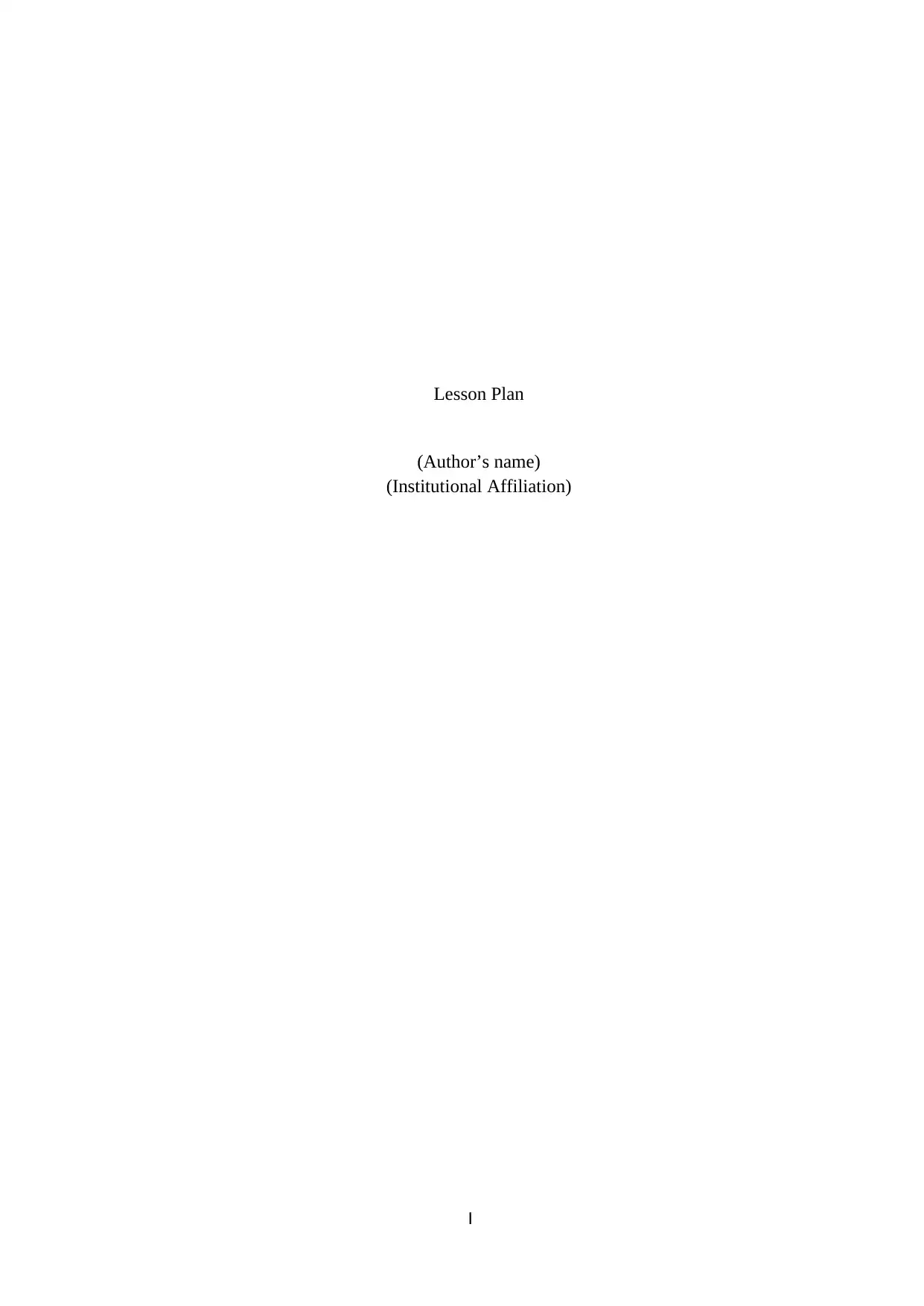
I
Lesson Plan
(Author’s name)
(Institutional Affiliation)
Lesson Plan
(Author’s name)
(Institutional Affiliation)
Paraphrase This Document
Need a fresh take? Get an instant paraphrase of this document with our AI Paraphraser
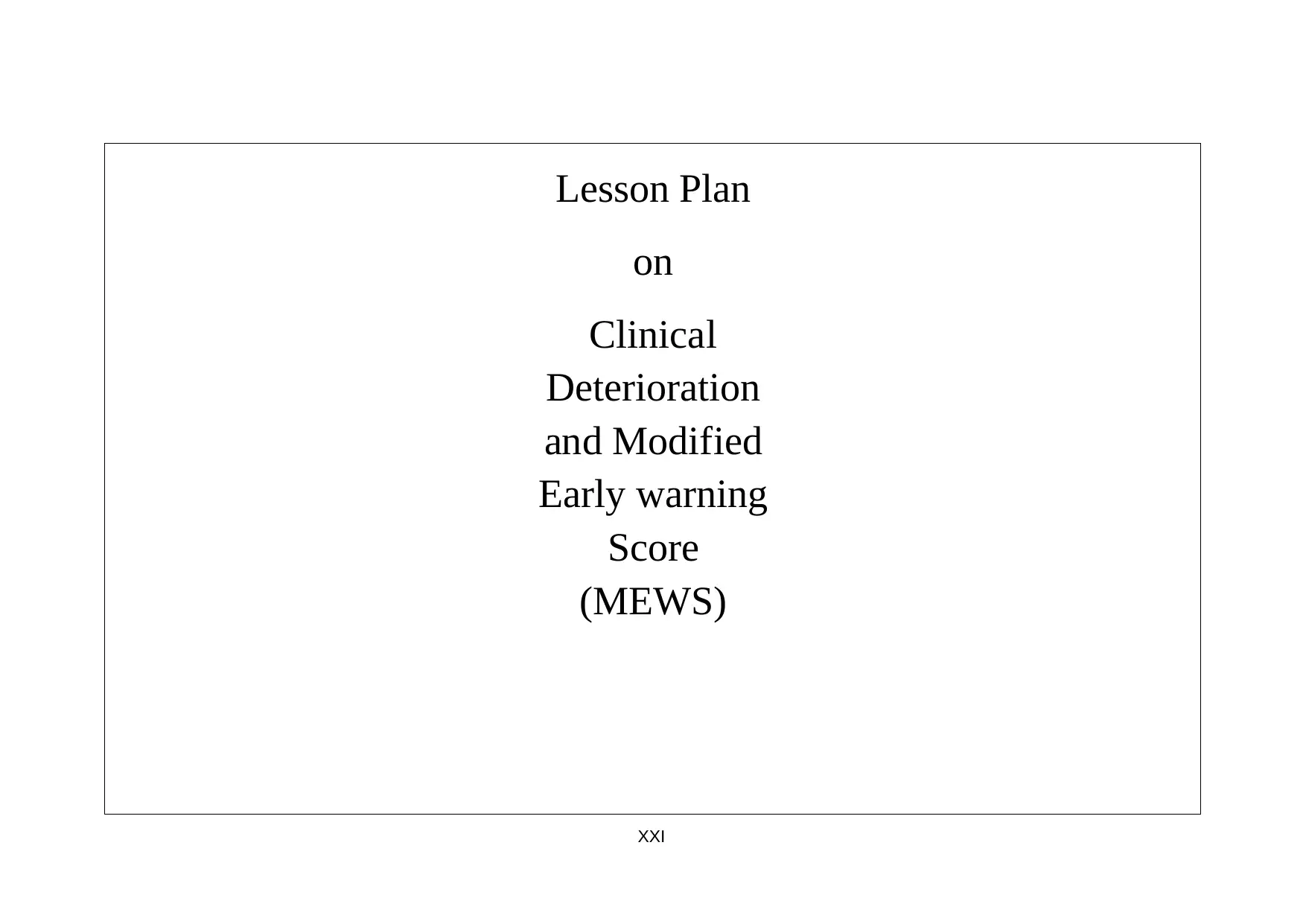
XXI
Lesson Plan
on
Clinical
Deterioration
and Modified
Early warning
Score
(MEWS)
Lesson Plan
on
Clinical
Deterioration
and Modified
Early warning
Score
(MEWS)
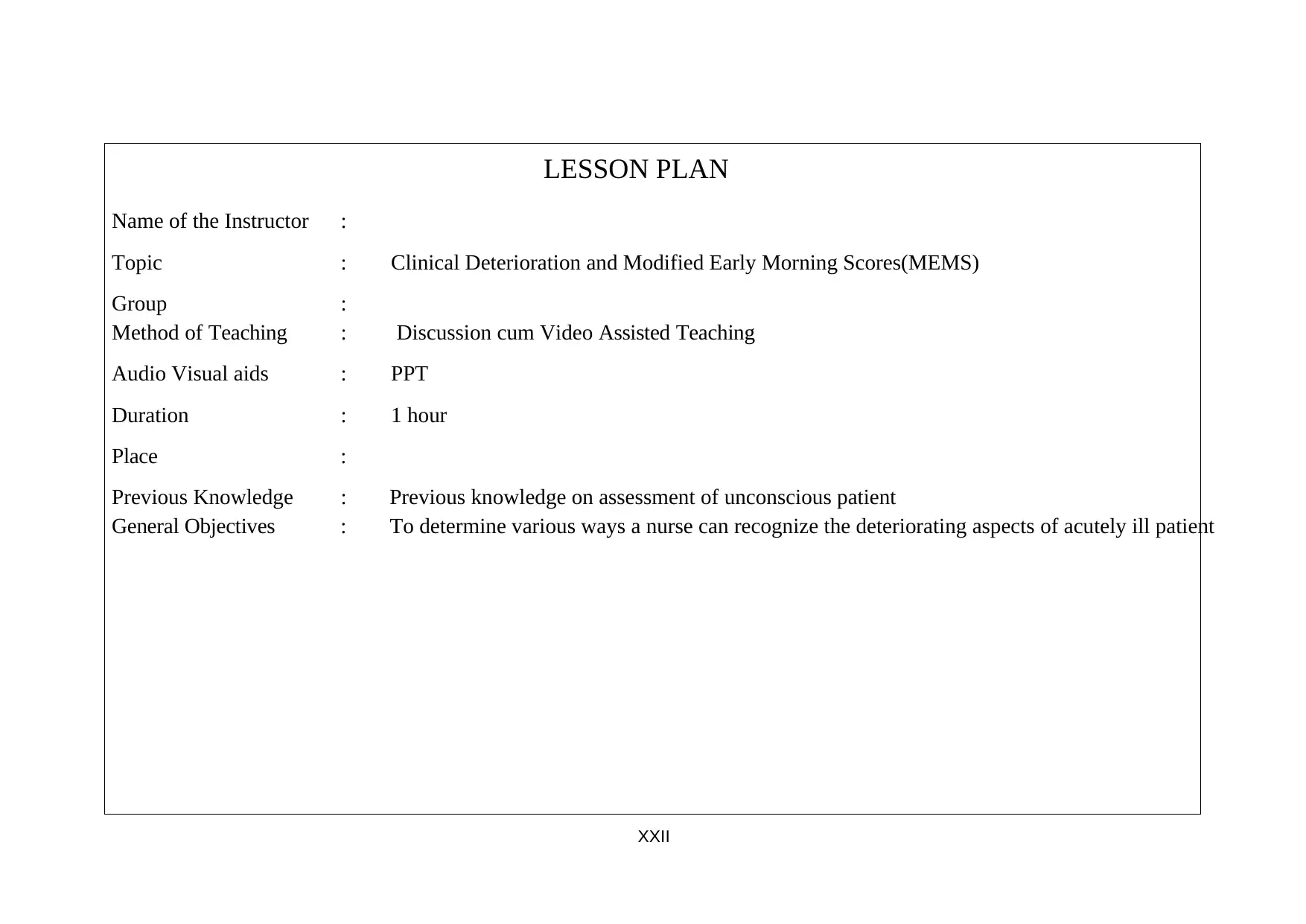
XXII
LESSON PLAN
Name of the Instructor :
Topic : Clinical Deterioration and Modified Early Morning Scores(MEMS)
Group :
Method of Teaching : Discussion cum Video Assisted Teaching
Audio Visual aids : PPT
Duration : 1 hour
Place :
Previous Knowledge : Previous knowledge on assessment of unconscious patient
General Objectives : To determine various ways a nurse can recognize the deteriorating aspects of acutely ill patient
LESSON PLAN
Name of the Instructor :
Topic : Clinical Deterioration and Modified Early Morning Scores(MEMS)
Group :
Method of Teaching : Discussion cum Video Assisted Teaching
Audio Visual aids : PPT
Duration : 1 hour
Place :
Previous Knowledge : Previous knowledge on assessment of unconscious patient
General Objectives : To determine various ways a nurse can recognize the deteriorating aspects of acutely ill patient
⊘ This is a preview!⊘
Do you want full access?
Subscribe today to unlock all pages.

Trusted by 1+ million students worldwide
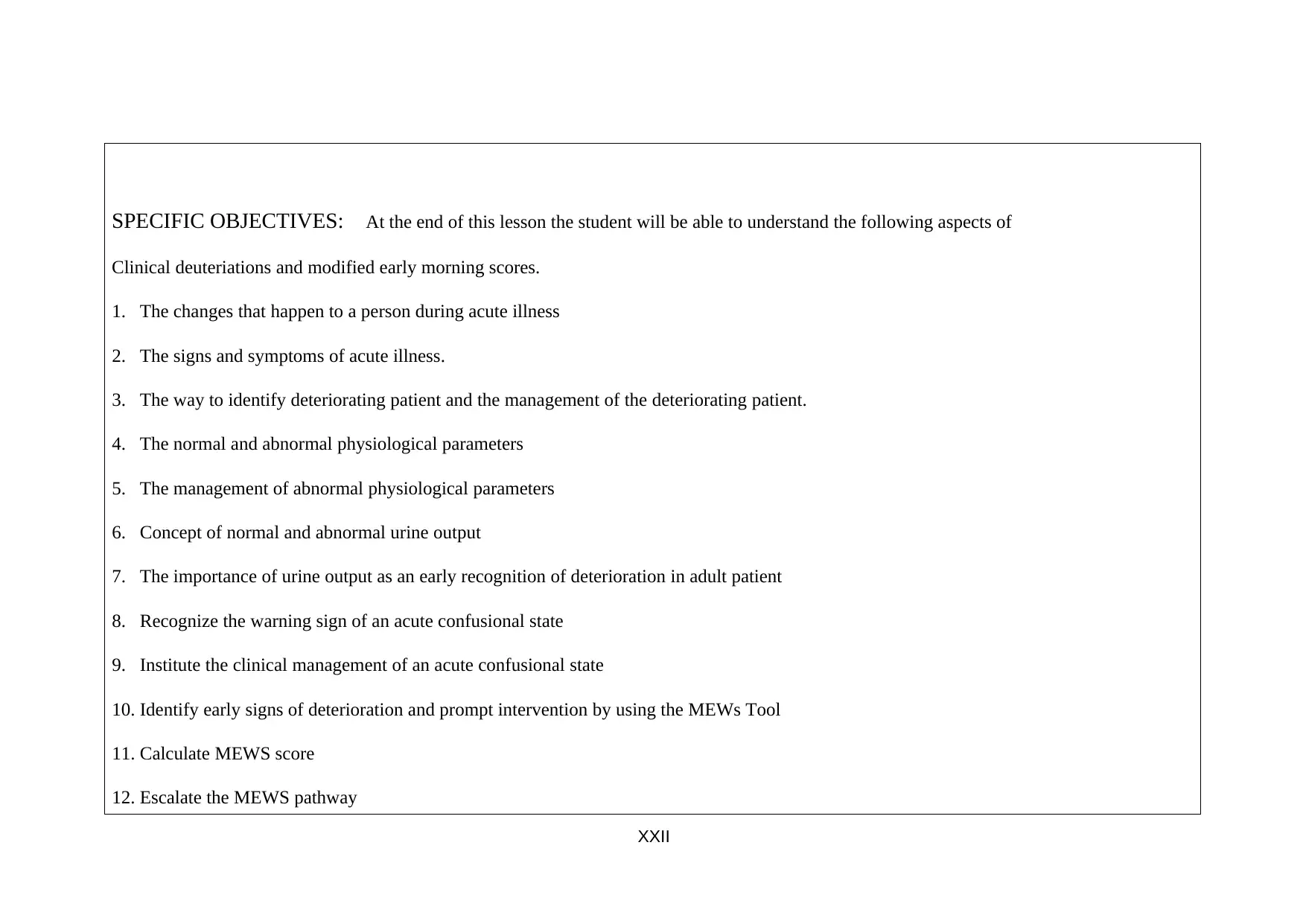
XXII
I
SPECIFIC OBJECTIVES: At the end of this lesson the student will be able to understand the following aspects of
Clinical deuteriations and modified early morning scores.
1. The changes that happen to a person during acute illness
2. The signs and symptoms of acute illness.
3. The way to identify deteriorating patient and the management of the deteriorating patient.
4. The normal and abnormal physiological parameters
5. The management of abnormal physiological parameters
6. Concept of normal and abnormal urine output
7. The importance of urine output as an early recognition of deterioration in adult patient
8. Recognize the warning sign of an acute confusional state
9. Institute the clinical management of an acute confusional state
10. Identify early signs of deterioration and prompt intervention by using the MEWs Tool
11. Calculate MEWS score
12. Escalate the MEWS pathway
I
SPECIFIC OBJECTIVES: At the end of this lesson the student will be able to understand the following aspects of
Clinical deuteriations and modified early morning scores.
1. The changes that happen to a person during acute illness
2. The signs and symptoms of acute illness.
3. The way to identify deteriorating patient and the management of the deteriorating patient.
4. The normal and abnormal physiological parameters
5. The management of abnormal physiological parameters
6. Concept of normal and abnormal urine output
7. The importance of urine output as an early recognition of deterioration in adult patient
8. Recognize the warning sign of an acute confusional state
9. Institute the clinical management of an acute confusional state
10. Identify early signs of deterioration and prompt intervention by using the MEWs Tool
11. Calculate MEWS score
12. Escalate the MEWS pathway
Paraphrase This Document
Need a fresh take? Get an instant paraphrase of this document with our AI Paraphraser
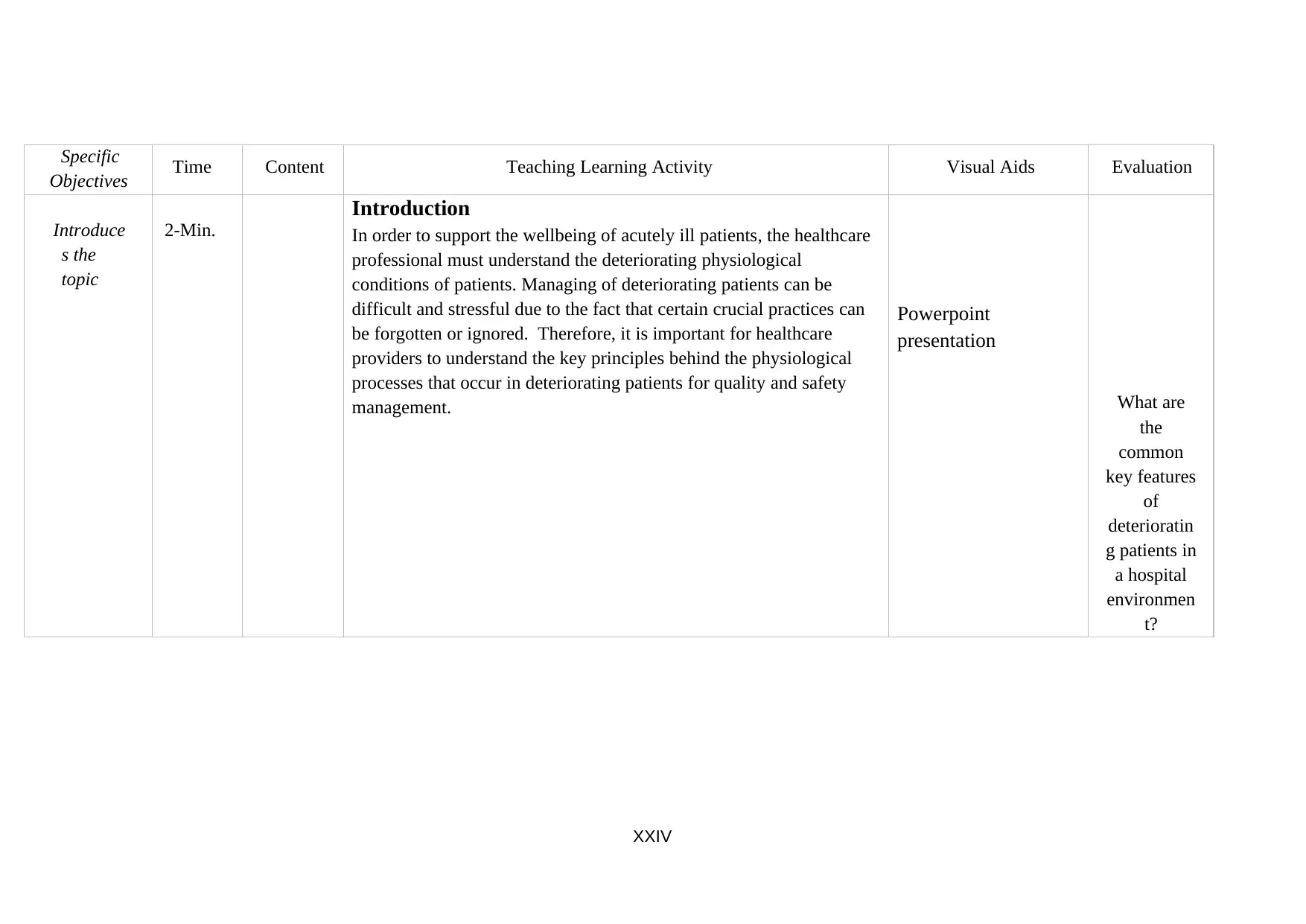
XXIV
Specific
Objectives Time Content Teaching Learning Activity Visual Aids Evaluation
Introduce
s the
topic
2-Min.
Introduction
In order to support the wellbeing of acutely ill patients, the healthcare
professional must understand the deteriorating physiological
conditions of patients. Managing of deteriorating patients can be
difficult and stressful due to the fact that certain crucial practices can
be forgotten or ignored. Therefore, it is important for healthcare
providers to understand the key principles behind the physiological
processes that occur in deteriorating patients for quality and safety
management.
Powerpoint
presentation
What are
the
common
key features
of
deterioratin
g patients in
a hospital
environmen
t?
Specific
Objectives Time Content Teaching Learning Activity Visual Aids Evaluation
Introduce
s the
topic
2-Min.
Introduction
In order to support the wellbeing of acutely ill patients, the healthcare
professional must understand the deteriorating physiological
conditions of patients. Managing of deteriorating patients can be
difficult and stressful due to the fact that certain crucial practices can
be forgotten or ignored. Therefore, it is important for healthcare
providers to understand the key principles behind the physiological
processes that occur in deteriorating patients for quality and safety
management.
Powerpoint
presentation
What are
the
common
key features
of
deterioratin
g patients in
a hospital
environmen
t?
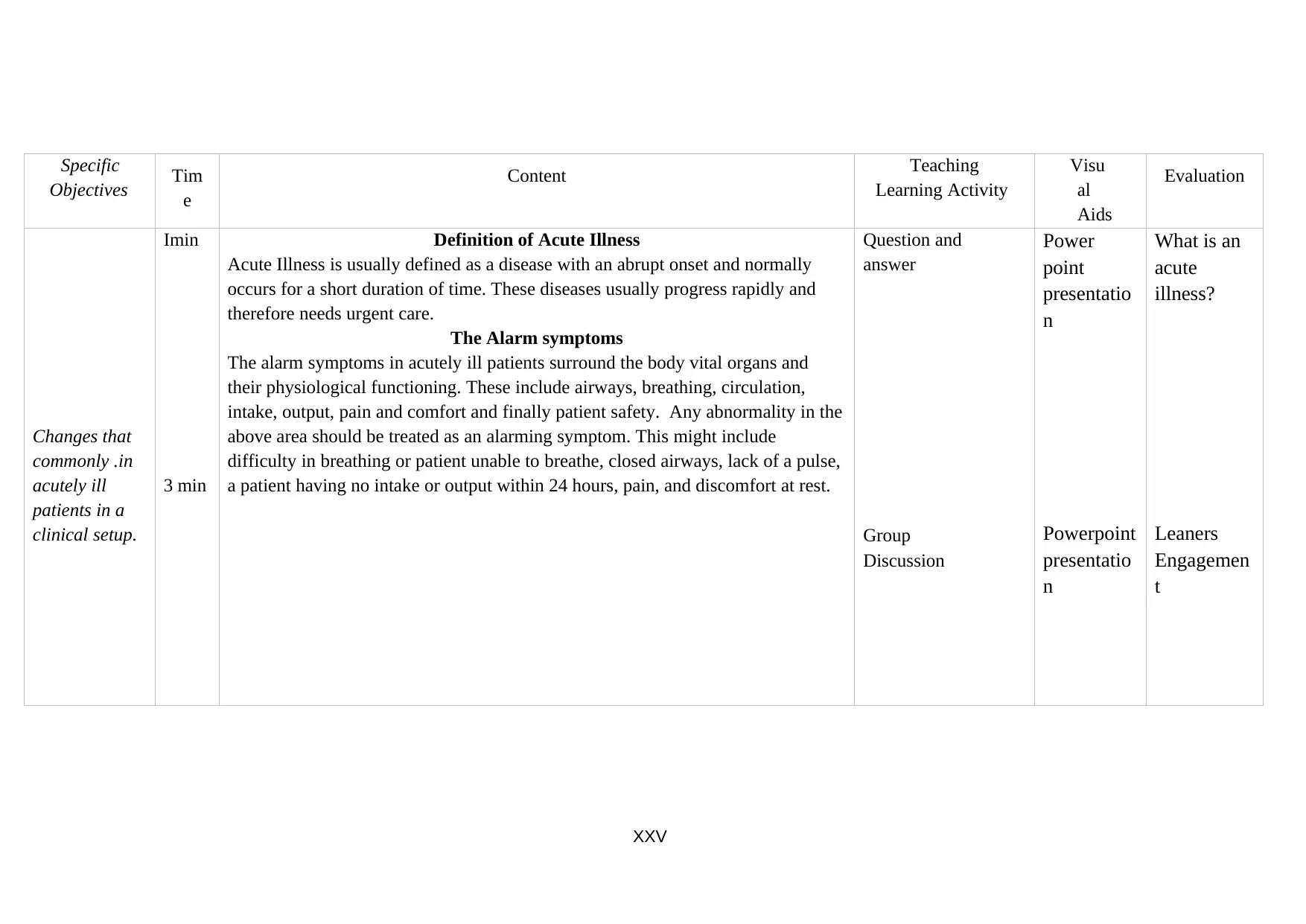
XXV
Specific
Objectives Tim
e
Content Teaching
Learning Activity
Visu
al
Aids
Evaluation
Changes that
commonly .in
acutely ill
patients in a
clinical setup.
Imin
3 min
Definition of Acute Illness
Acute Illness is usually defined as a disease with an abrupt onset and normally
occurs for a short duration of time. These diseases usually progress rapidly and
therefore needs urgent care.
The Alarm symptoms
The alarm symptoms in acutely ill patients surround the body vital organs and
their physiological functioning. These include airways, breathing, circulation,
intake, output, pain and comfort and finally patient safety. Any abnormality in the
above area should be treated as an alarming symptom. This might include
difficulty in breathing or patient unable to breathe, closed airways, lack of a pulse,
a patient having no intake or output within 24 hours, pain, and discomfort at rest.
Question and
answer
Group
Discussion
Power
point
presentatio
n
Powerpoint
presentatio
n
What is an
acute
illness?
Leaners
Engagemen
t
Specific
Objectives Tim
e
Content Teaching
Learning Activity
Visu
al
Aids
Evaluation
Changes that
commonly .in
acutely ill
patients in a
clinical setup.
Imin
3 min
Definition of Acute Illness
Acute Illness is usually defined as a disease with an abrupt onset and normally
occurs for a short duration of time. These diseases usually progress rapidly and
therefore needs urgent care.
The Alarm symptoms
The alarm symptoms in acutely ill patients surround the body vital organs and
their physiological functioning. These include airways, breathing, circulation,
intake, output, pain and comfort and finally patient safety. Any abnormality in the
above area should be treated as an alarming symptom. This might include
difficulty in breathing or patient unable to breathe, closed airways, lack of a pulse,
a patient having no intake or output within 24 hours, pain, and discomfort at rest.
Question and
answer
Group
Discussion
Power
point
presentatio
n
Powerpoint
presentatio
n
What is an
acute
illness?
Leaners
Engagemen
t
⊘ This is a preview!⊘
Do you want full access?
Subscribe today to unlock all pages.

Trusted by 1+ million students worldwide
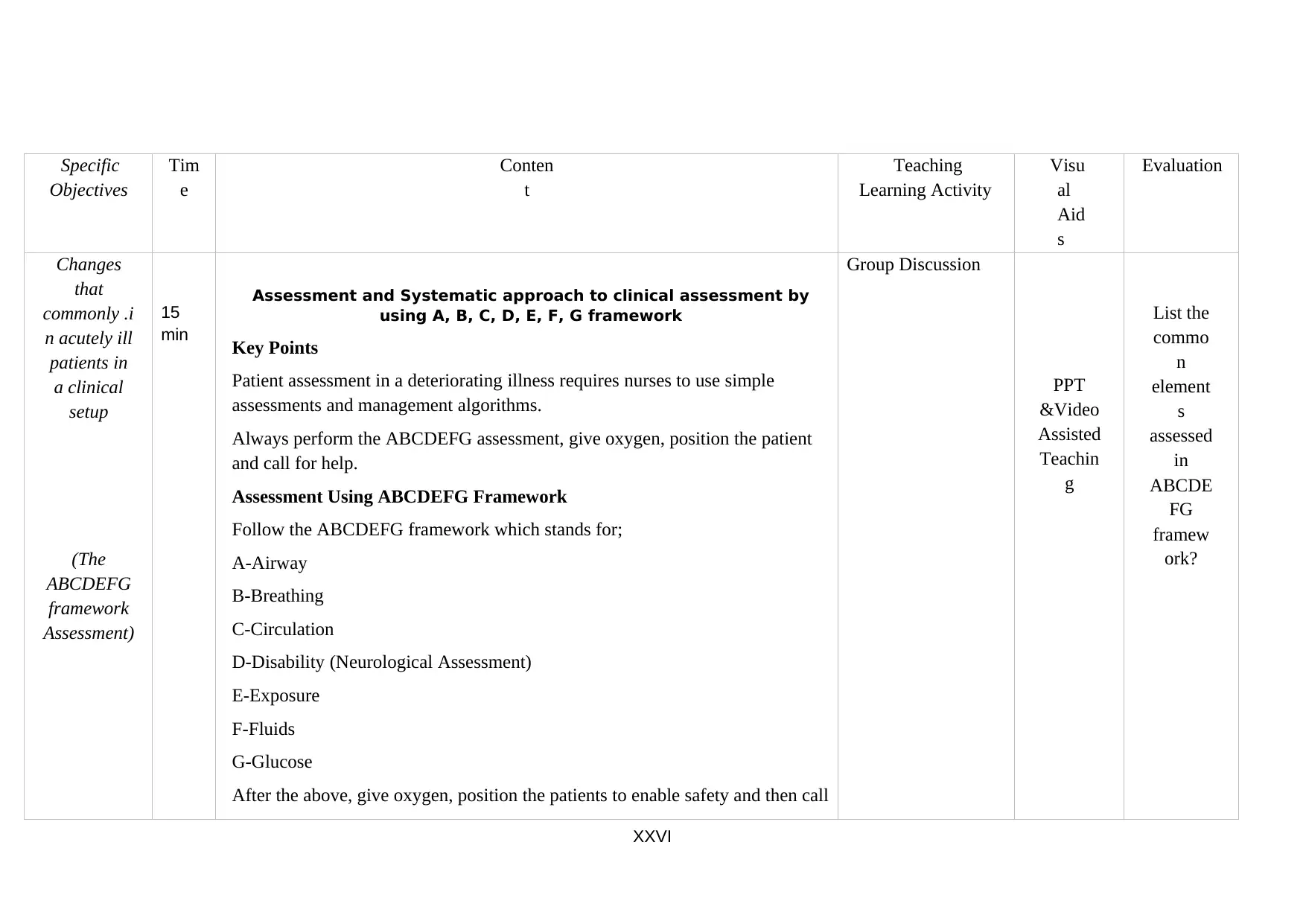
XXVI
Specific
Objectives
Tim
e
Conten
t
Teaching
Learning Activity
Visu
al
Aid
s
Evaluation
Changes
that
commonly .i
n acutely ill
patients in
a clinical
setup
(The
ABCDEFG
framework
Assessment)
15
min
Assessment and Systematic approach to clinical assessment by
using A, B, C, D, E, F, G framework
Key Points
Patient assessment in a deteriorating illness requires nurses to use simple
assessments and management algorithms.
Always perform the ABCDEFG assessment, give oxygen, position the patient
and call for help.
Assessment Using ABCDEFG Framework
Follow the ABCDEFG framework which stands for;
A-Airway
B-Breathing
C-Circulation
D-Disability (Neurological Assessment)
E-Exposure
F-Fluids
G-Glucose
After the above, give oxygen, position the patients to enable safety and then call
Group Discussion
PPT
&Video
Assisted
Teachin
g
List the
commo
n
element
s
assessed
in
ABCDE
FG
framew
ork?
Specific
Objectives
Tim
e
Conten
t
Teaching
Learning Activity
Visu
al
Aid
s
Evaluation
Changes
that
commonly .i
n acutely ill
patients in
a clinical
setup
(The
ABCDEFG
framework
Assessment)
15
min
Assessment and Systematic approach to clinical assessment by
using A, B, C, D, E, F, G framework
Key Points
Patient assessment in a deteriorating illness requires nurses to use simple
assessments and management algorithms.
Always perform the ABCDEFG assessment, give oxygen, position the patient
and call for help.
Assessment Using ABCDEFG Framework
Follow the ABCDEFG framework which stands for;
A-Airway
B-Breathing
C-Circulation
D-Disability (Neurological Assessment)
E-Exposure
F-Fluids
G-Glucose
After the above, give oxygen, position the patients to enable safety and then call
Group Discussion
PPT
&Video
Assisted
Teachin
g
List the
commo
n
element
s
assessed
in
ABCDE
FG
framew
ork?
Paraphrase This Document
Need a fresh take? Get an instant paraphrase of this document with our AI Paraphraser
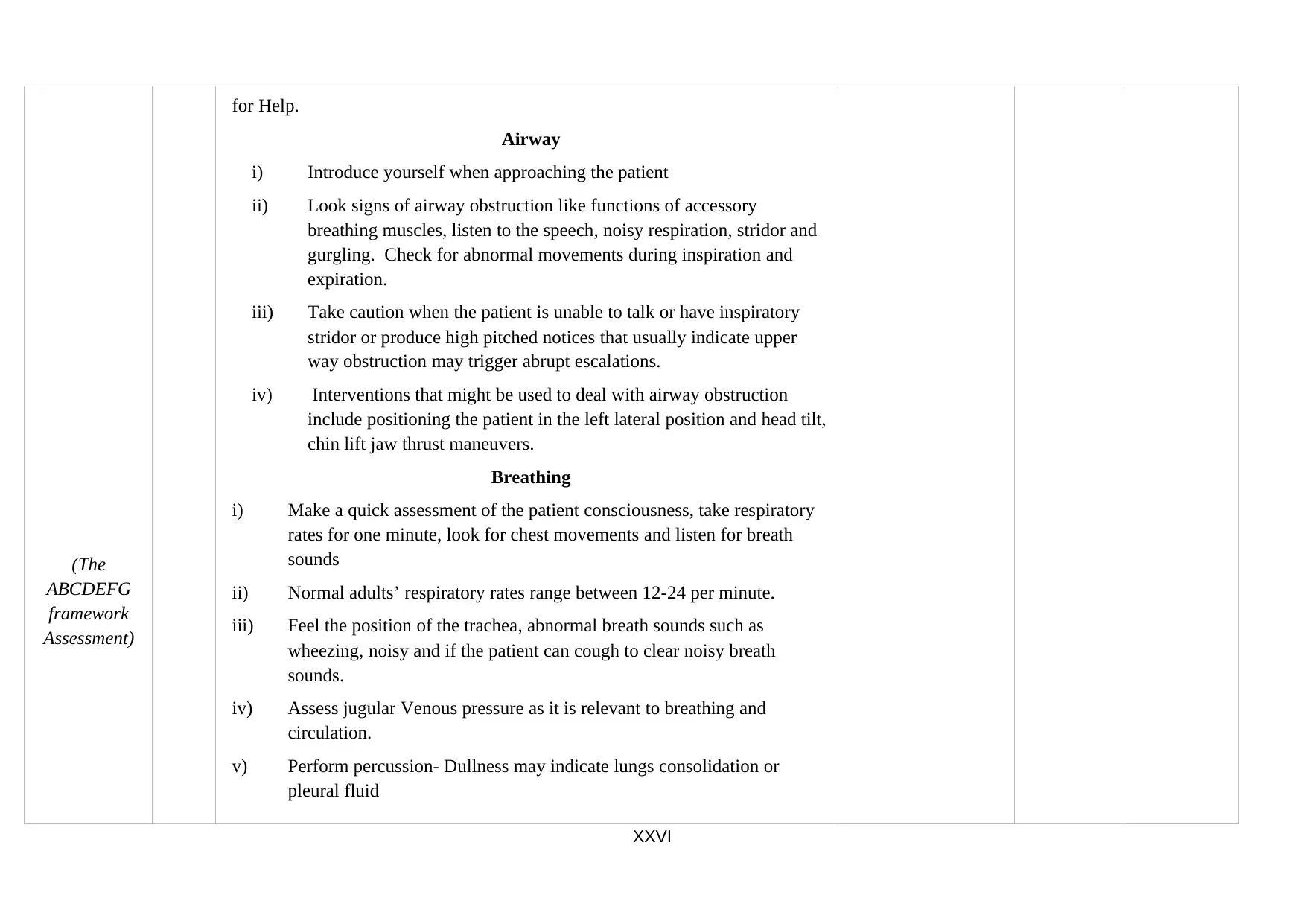
XXVI
I
(The
ABCDEFG
framework
Assessment)
for Help.
Airway
i) Introduce yourself when approaching the patient
ii) Look signs of airway obstruction like functions of accessory
breathing muscles, listen to the speech, noisy respiration, stridor and
gurgling. Check for abnormal movements during inspiration and
expiration.
iii) Take caution when the patient is unable to talk or have inspiratory
stridor or produce high pitched notices that usually indicate upper
way obstruction may trigger abrupt escalations.
iv) Interventions that might be used to deal with airway obstruction
include positioning the patient in the left lateral position and head tilt,
chin lift jaw thrust maneuvers.
Breathing
i) Make a quick assessment of the patient consciousness, take respiratory
rates for one minute, look for chest movements and listen for breath
sounds
ii) Normal adults’ respiratory rates range between 12-24 per minute.
iii) Feel the position of the trachea, abnormal breath sounds such as
wheezing, noisy and if the patient can cough to clear noisy breath
sounds.
iv) Assess jugular Venous pressure as it is relevant to breathing and
circulation.
v) Perform percussion- Dullness may indicate lungs consolidation or
pleural fluid
I
(The
ABCDEFG
framework
Assessment)
for Help.
Airway
i) Introduce yourself when approaching the patient
ii) Look signs of airway obstruction like functions of accessory
breathing muscles, listen to the speech, noisy respiration, stridor and
gurgling. Check for abnormal movements during inspiration and
expiration.
iii) Take caution when the patient is unable to talk or have inspiratory
stridor or produce high pitched notices that usually indicate upper
way obstruction may trigger abrupt escalations.
iv) Interventions that might be used to deal with airway obstruction
include positioning the patient in the left lateral position and head tilt,
chin lift jaw thrust maneuvers.
Breathing
i) Make a quick assessment of the patient consciousness, take respiratory
rates for one minute, look for chest movements and listen for breath
sounds
ii) Normal adults’ respiratory rates range between 12-24 per minute.
iii) Feel the position of the trachea, abnormal breath sounds such as
wheezing, noisy and if the patient can cough to clear noisy breath
sounds.
iv) Assess jugular Venous pressure as it is relevant to breathing and
circulation.
v) Perform percussion- Dullness may indicate lungs consolidation or
pleural fluid
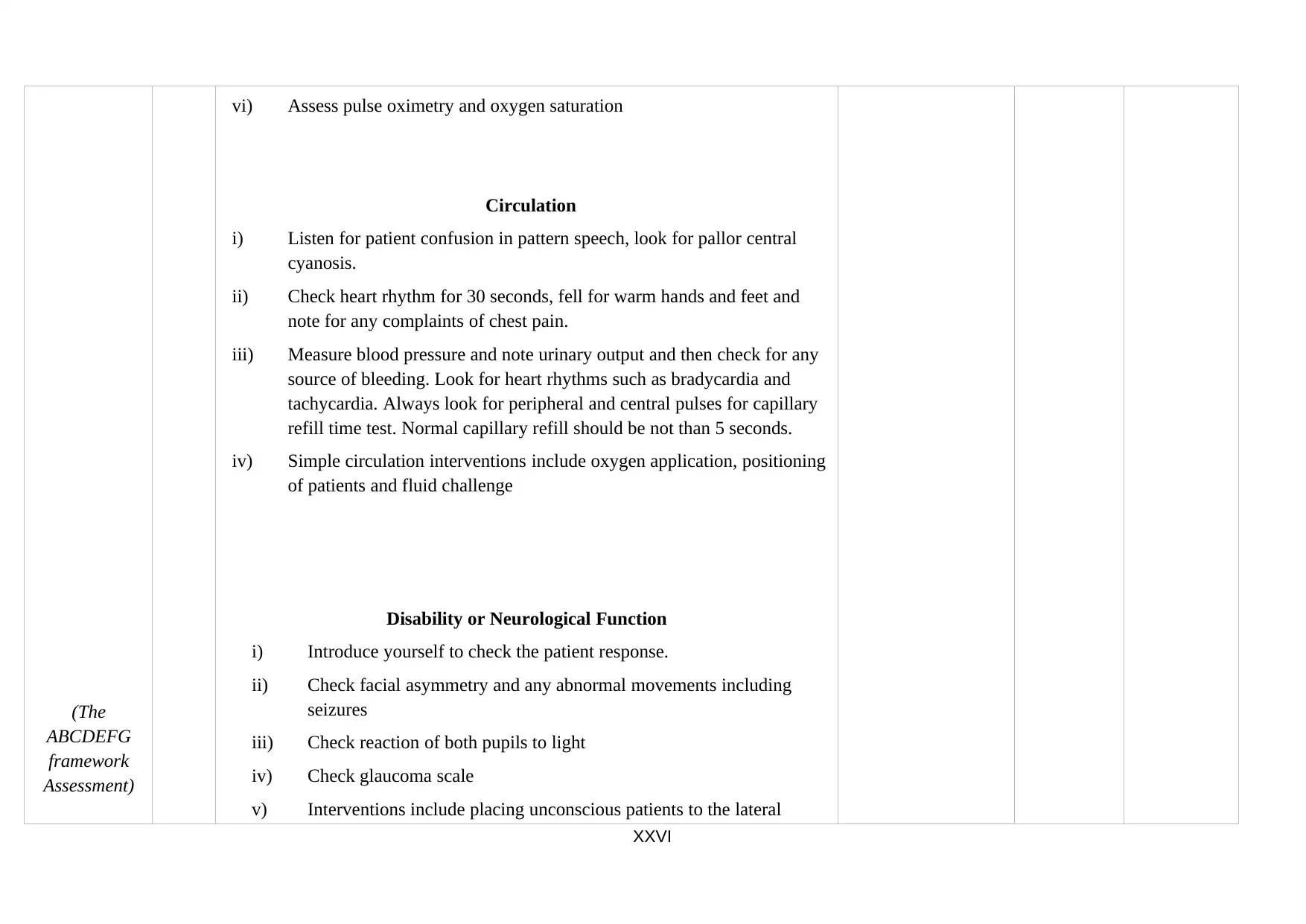
XXVI
II
(The
ABCDEFG
framework
Assessment)
vi) Assess pulse oximetry and oxygen saturation
Circulation
i) Listen for patient confusion in pattern speech, look for pallor central
cyanosis.
ii) Check heart rhythm for 30 seconds, fell for warm hands and feet and
note for any complaints of chest pain.
iii) Measure blood pressure and note urinary output and then check for any
source of bleeding. Look for heart rhythms such as bradycardia and
tachycardia. Always look for peripheral and central pulses for capillary
refill time test. Normal capillary refill should be not than 5 seconds.
iv) Simple circulation interventions include oxygen application, positioning
of patients and fluid challenge
Disability or Neurological Function
i) Introduce yourself to check the patient response.
ii) Check facial asymmetry and any abnormal movements including
seizures
iii) Check reaction of both pupils to light
iv) Check glaucoma scale
v) Interventions include placing unconscious patients to the lateral
II
(The
ABCDEFG
framework
Assessment)
vi) Assess pulse oximetry and oxygen saturation
Circulation
i) Listen for patient confusion in pattern speech, look for pallor central
cyanosis.
ii) Check heart rhythm for 30 seconds, fell for warm hands and feet and
note for any complaints of chest pain.
iii) Measure blood pressure and note urinary output and then check for any
source of bleeding. Look for heart rhythms such as bradycardia and
tachycardia. Always look for peripheral and central pulses for capillary
refill time test. Normal capillary refill should be not than 5 seconds.
iv) Simple circulation interventions include oxygen application, positioning
of patients and fluid challenge
Disability or Neurological Function
i) Introduce yourself to check the patient response.
ii) Check facial asymmetry and any abnormal movements including
seizures
iii) Check reaction of both pupils to light
iv) Check glaucoma scale
v) Interventions include placing unconscious patients to the lateral
⊘ This is a preview!⊘
Do you want full access?
Subscribe today to unlock all pages.

Trusted by 1+ million students worldwide
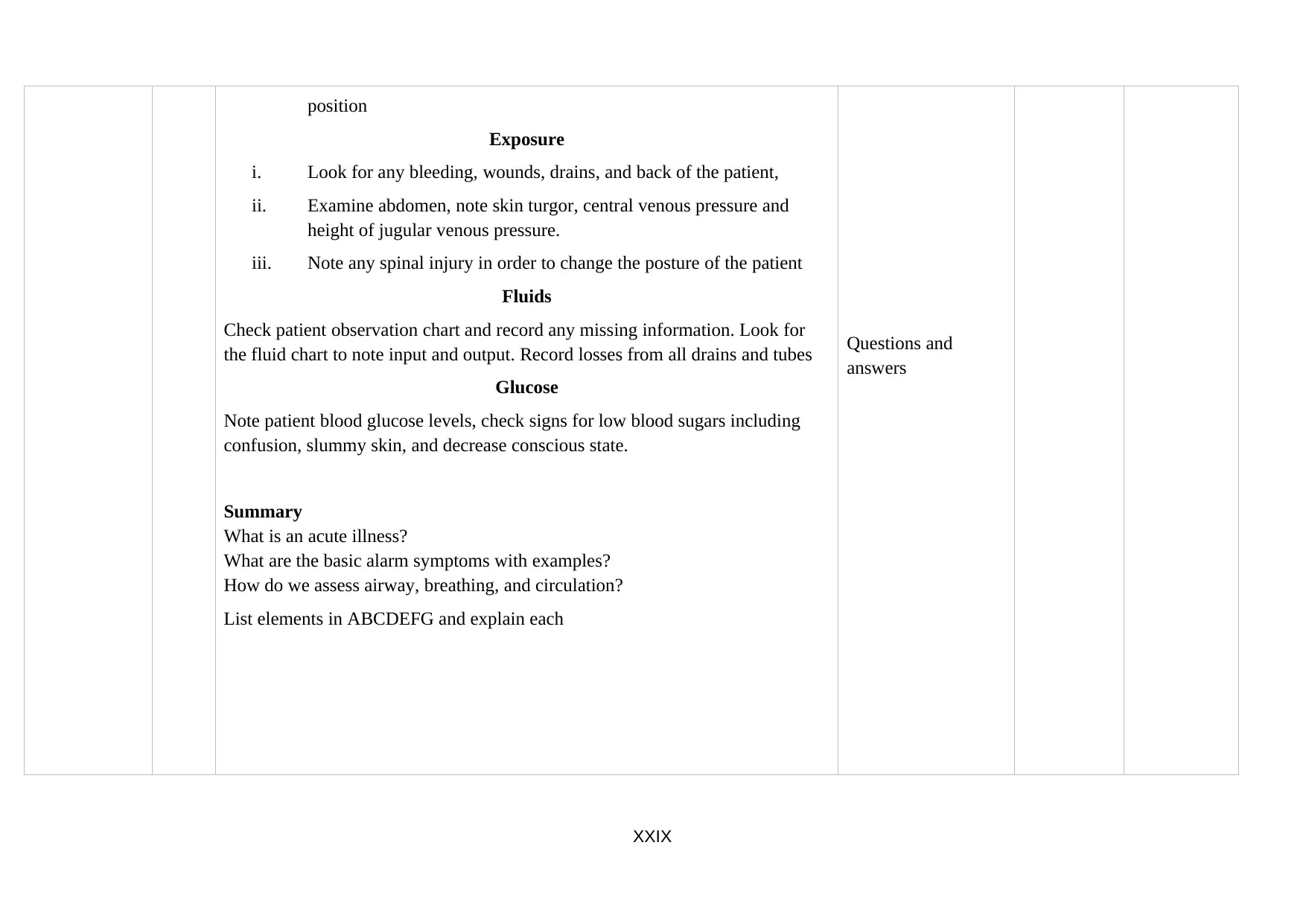
XXIX
position
Exposure
i. Look for any bleeding, wounds, drains, and back of the patient,
ii. Examine abdomen, note skin turgor, central venous pressure and
height of jugular venous pressure.
iii. Note any spinal injury in order to change the posture of the patient
Fluids
Check patient observation chart and record any missing information. Look for
the fluid chart to note input and output. Record losses from all drains and tubes
Glucose
Note patient blood glucose levels, check signs for low blood sugars including
confusion, slummy skin, and decrease conscious state.
Summary
What is an acute illness?
What are the basic alarm symptoms with examples?
How do we assess airway, breathing, and circulation?
List elements in ABCDEFG and explain each
Questions and
answers
position
Exposure
i. Look for any bleeding, wounds, drains, and back of the patient,
ii. Examine abdomen, note skin turgor, central venous pressure and
height of jugular venous pressure.
iii. Note any spinal injury in order to change the posture of the patient
Fluids
Check patient observation chart and record any missing information. Look for
the fluid chart to note input and output. Record losses from all drains and tubes
Glucose
Note patient blood glucose levels, check signs for low blood sugars including
confusion, slummy skin, and decrease conscious state.
Summary
What is an acute illness?
What are the basic alarm symptoms with examples?
How do we assess airway, breathing, and circulation?
List elements in ABCDEFG and explain each
Questions and
answers
Paraphrase This Document
Need a fresh take? Get an instant paraphrase of this document with our AI Paraphraser
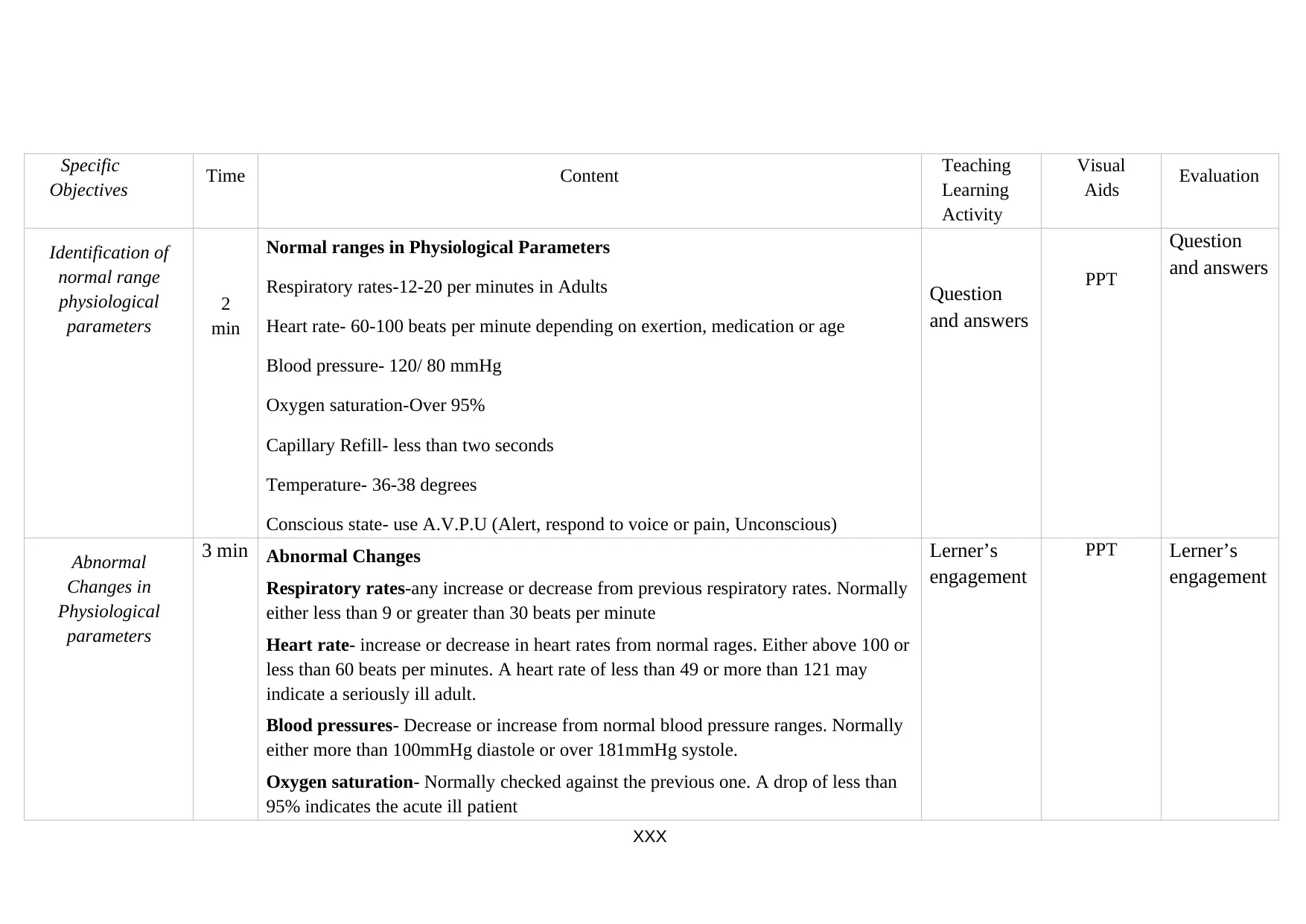
XXX
Specific
Objectives Time Content Teaching
Learning
Activity
Visual
Aids Evaluation
Identification of
normal range
physiological
parameters
2
min
Normal ranges in Physiological Parameters
Respiratory rates-12-20 per minutes in Adults
Heart rate- 60-100 beats per minute depending on exertion, medication or age
Blood pressure- 120/ 80 mmHg
Oxygen saturation-Over 95%
Capillary Refill- less than two seconds
Temperature- 36-38 degrees
Conscious state- use A.V.P.U (Alert, respond to voice or pain, Unconscious)
Question
and answers
PPT
Question
and answers
Abnormal
Changes in
Physiological
parameters
3 min Abnormal Changes
Respiratory rates-any increase or decrease from previous respiratory rates. Normally
either less than 9 or greater than 30 beats per minute
Heart rate- increase or decrease in heart rates from normal rages. Either above 100 or
less than 60 beats per minutes. A heart rate of less than 49 or more than 121 may
indicate a seriously ill adult.
Blood pressures- Decrease or increase from normal blood pressure ranges. Normally
either more than 100mmHg diastole or over 181mmHg systole.
Oxygen saturation- Normally checked against the previous one. A drop of less than
95% indicates the acute ill patient
Lerner’s
engagement
PPT Lerner’s
engagement
Specific
Objectives Time Content Teaching
Learning
Activity
Visual
Aids Evaluation
Identification of
normal range
physiological
parameters
2
min
Normal ranges in Physiological Parameters
Respiratory rates-12-20 per minutes in Adults
Heart rate- 60-100 beats per minute depending on exertion, medication or age
Blood pressure- 120/ 80 mmHg
Oxygen saturation-Over 95%
Capillary Refill- less than two seconds
Temperature- 36-38 degrees
Conscious state- use A.V.P.U (Alert, respond to voice or pain, Unconscious)
Question
and answers
PPT
Question
and answers
Abnormal
Changes in
Physiological
parameters
3 min Abnormal Changes
Respiratory rates-any increase or decrease from previous respiratory rates. Normally
either less than 9 or greater than 30 beats per minute
Heart rate- increase or decrease in heart rates from normal rages. Either above 100 or
less than 60 beats per minutes. A heart rate of less than 49 or more than 121 may
indicate a seriously ill adult.
Blood pressures- Decrease or increase from normal blood pressure ranges. Normally
either more than 100mmHg diastole or over 181mmHg systole.
Oxygen saturation- Normally checked against the previous one. A drop of less than
95% indicates the acute ill patient
Lerner’s
engagement
PPT Lerner’s
engagement
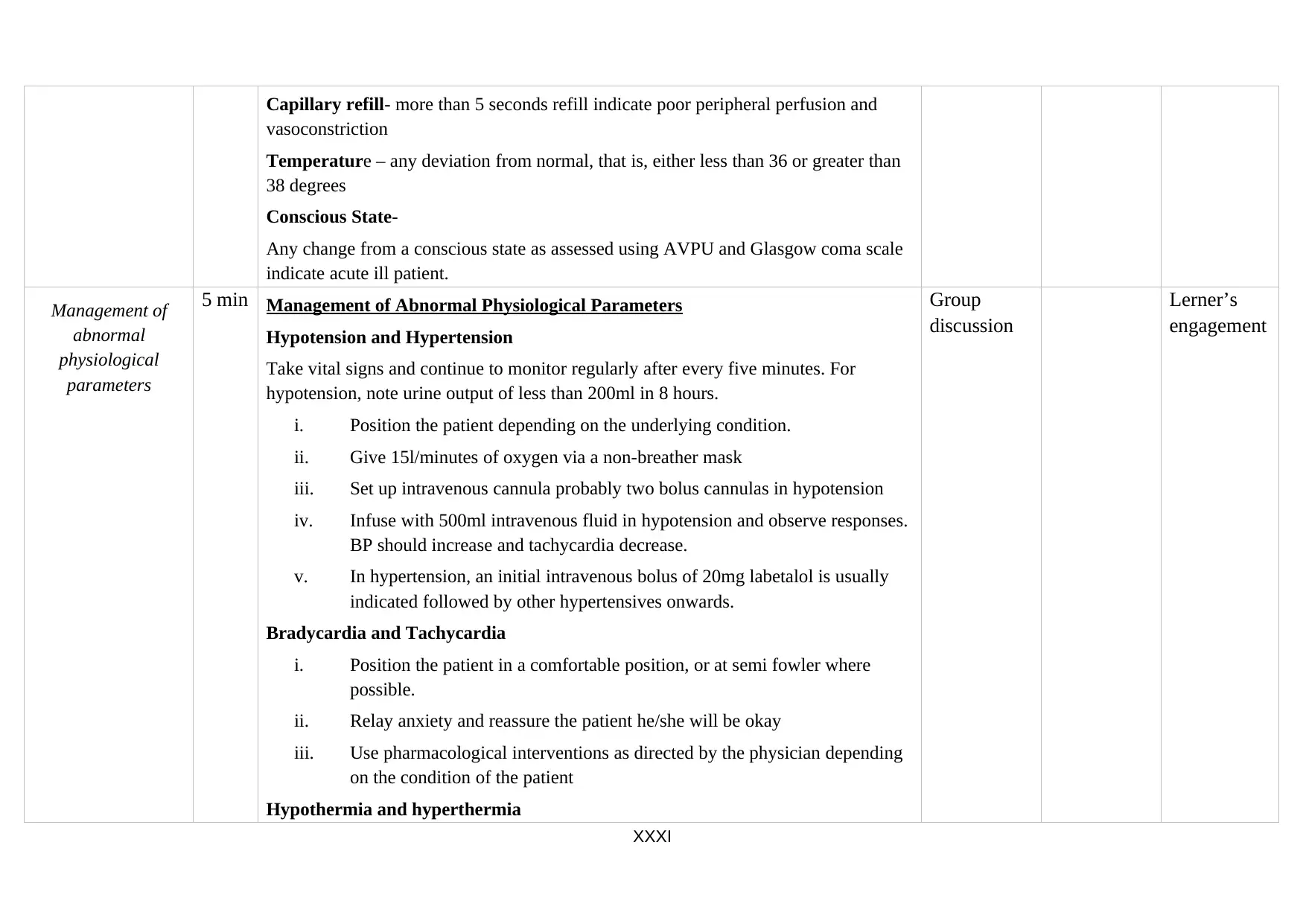
XXXI
Capillary refill- more than 5 seconds refill indicate poor peripheral perfusion and
vasoconstriction
Temperature – any deviation from normal, that is, either less than 36 or greater than
38 degrees
Conscious State-
Any change from a conscious state as assessed using AVPU and Glasgow coma scale
indicate acute ill patient.
Management of
abnormal
physiological
parameters
5 min Management of Abnormal Physiological Parameters
Hypotension and Hypertension
Take vital signs and continue to monitor regularly after every five minutes. For
hypotension, note urine output of less than 200ml in 8 hours.
i. Position the patient depending on the underlying condition.
ii. Give 15l/minutes of oxygen via a non-breather mask
iii. Set up intravenous cannula probably two bolus cannulas in hypotension
iv. Infuse with 500ml intravenous fluid in hypotension and observe responses.
BP should increase and tachycardia decrease.
v. In hypertension, an initial intravenous bolus of 20mg labetalol is usually
indicated followed by other hypertensives onwards.
Bradycardia and Tachycardia
i. Position the patient in a comfortable position, or at semi fowler where
possible.
ii. Relay anxiety and reassure the patient he/she will be okay
iii. Use pharmacological interventions as directed by the physician depending
on the condition of the patient
Hypothermia and hyperthermia
Group
discussion
Lerner’s
engagement
Capillary refill- more than 5 seconds refill indicate poor peripheral perfusion and
vasoconstriction
Temperature – any deviation from normal, that is, either less than 36 or greater than
38 degrees
Conscious State-
Any change from a conscious state as assessed using AVPU and Glasgow coma scale
indicate acute ill patient.
Management of
abnormal
physiological
parameters
5 min Management of Abnormal Physiological Parameters
Hypotension and Hypertension
Take vital signs and continue to monitor regularly after every five minutes. For
hypotension, note urine output of less than 200ml in 8 hours.
i. Position the patient depending on the underlying condition.
ii. Give 15l/minutes of oxygen via a non-breather mask
iii. Set up intravenous cannula probably two bolus cannulas in hypotension
iv. Infuse with 500ml intravenous fluid in hypotension and observe responses.
BP should increase and tachycardia decrease.
v. In hypertension, an initial intravenous bolus of 20mg labetalol is usually
indicated followed by other hypertensives onwards.
Bradycardia and Tachycardia
i. Position the patient in a comfortable position, or at semi fowler where
possible.
ii. Relay anxiety and reassure the patient he/she will be okay
iii. Use pharmacological interventions as directed by the physician depending
on the condition of the patient
Hypothermia and hyperthermia
Group
discussion
Lerner’s
engagement
⊘ This is a preview!⊘
Do you want full access?
Subscribe today to unlock all pages.

Trusted by 1+ million students worldwide
1 out of 28
Your All-in-One AI-Powered Toolkit for Academic Success.
+13062052269
info@desklib.com
Available 24*7 on WhatsApp / Email
![[object Object]](/_next/static/media/star-bottom.7253800d.svg)
Unlock your academic potential
Copyright © 2020–2025 A2Z Services. All Rights Reserved. Developed and managed by ZUCOL.

